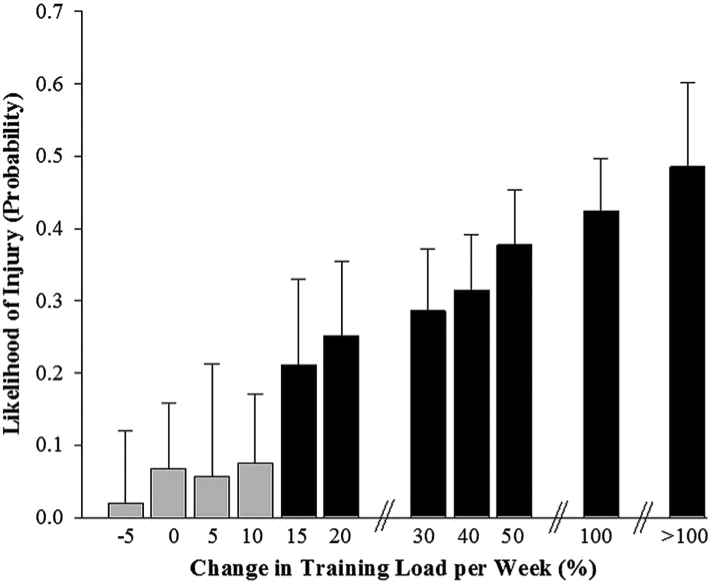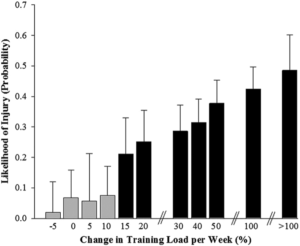The ‘golden rule’ to avoid injuries

I recently ran the Hamilton Half Marathon and as an (extremely) novice runner I enlisted the help of a running coach/programmer. I was attracted to his methodology as he uses a scientific approach to his programming (he was an engineer in a past life and has carried many of those traits through to his new career as a triathlon coach). Shocking (even to me) I was able to stay completely injury free through the summer of training and set a new PB which I was extremely happy about. I wondered how this happened so I looked back at my run programs and noticed a steady, slow increase in run volume that never exceeded 10% weekly. This is an old adage in run training, so I wondered if there is actual science to back it.
While doing reading on new research in athlete loading (see this blog for an update on the science of loading), I came across some unpublished data by Tim Gabbett who is one of the world research leaders in tissue loading.
We know for sure that high absolute training volume are directly associated with greater injury risk (in fact it is dose dependent meaning more training = more injury based on a week to week change). Past studies on Australian football players have shown that 40% of injuries are associated with a greater then 10% weekly training load change compared to the week before. This has also been showed in rugby. So why is this important?
Check out this graph below: This is unpublished data that models the relationship between changes in weekly training load (when reported as a percentage of the prior week) and the likelihood of injury (which as far as I can tell means any injury at al). You will find the following:
- When load was constant (ranging from 5-10% more than the prior week) athletes had a less then 10% injury risk.
- When load was equal or greater then 15% of the prior weeks load, injury risk went from under 10% all the way up to 21-49%!
- There is a clear dose dependent relationship meaning the more percentage change week by week in load volume caused an equal increase in injury probability.

Now this data includes both types of loading (internal and external – see our past blog on this topic to learn about the difference), but as a general rule that can be used across a number of sports, the 10% or less rule for weekly volume increase actually has scientific data which makes us happy as we have been touting it for years. In fact, in their paper, Gabbett goes as far as stating “To minimize the risk of injury, practitioners should limit weekly training load increases to under 10%”.
I actually emailed Dr. Gabbett to ask if they have used their research on running and triathlon athletes as they are likely the population most prone to overuse injuries. He replied that he and his research partner are so certain that their research would apply to runners that they are not even really considering following through with a research paper!
Your take home point – keep training volume under 10% for a week to week increase in whatever your athletic endeavor or else we will see you soon in clinic!
